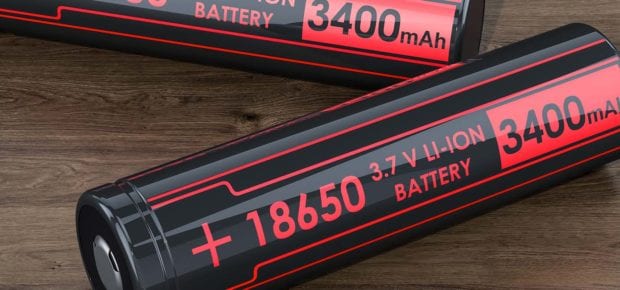April 21, 2019
Batteries already play a major role in how we use electronics. But as we move toward renewable energy sources, more technologies (like automotive) are beginning to rely entirely on electricity stored in batteries, and lots of it.
To handle these increased demands, engineers and technologists have been working to improve two main types of rechargeable batteries: the lithium-ion batteries we commonly see in electronics, and the lead-acid batteries used in more industrial applications.
Currently, battery anodes (the electrode at the end of the battery through which the current enters) are made out of carbon. One idea explored on IEEE Spectrum is to use silicon instead, since lithium ions combine with silicon, which “means a smaller amount of anode material can store a lot more lithium. Silicon anodes could thus provide much larger capacities.”
Many of the efficiency issues that lithium-ion batteries face “can be traced largely to dendrites, tiny threadlike structures that form on the surface of an electrode over repeated cycles of charging and discharging,” according to researchers at Dartmouth and Stanford. They tend to grow when the battery is overcharged, according to the article.
They also create cracks that expose lithium to the electrolyte, and the resulting chemical reaction depletes the amount of lithium available, making the battery less efficient. Additionally, since dendrites are fragile, they “often break off from the anode, generating ‘dead lithium’ that cannot be reused,” further lowering the efficiency of the cell, according to the researchers. Ultimately, to compensate for this loss, “today’s batteries must include excess lithium, which adds substantially to their weight and cost.”
By adding lithium polysulfide and lithium nitrate to the electrolyte, the researchers were able to limit dendrite growth and increase the battery’s stability.
Another method to prevent dendrite growth is being pioneered by a company in Massachusetts. Instead of changing the liquid components, they’re coating the anode with a polymer-ceramic electrolyte. They say these semi-solid batteries can store twice as much energy as a comparably-sized conventional lithium-ion battery.
What about the lead batteries we still use widely for things like cars? While you might not expect it, a battery industry workshop recap on IEEE Spectrum says “In terms of dollars per kilowatt-hour of energy, lead batteries are already the most cost-effective energy storage system available. And unlike alternative types of storage, lead batteries are fully recyclable, allowing for minimal waste from their usage.” Participants in the workshop are focused on extending the cycle life of lead batteries and improving their charging process.
Progress in battery technology is particularly exciting from an environmental sustainability perspective. As solar panels become significantly more powerful, storing the power they generate is essential to improving our current grid without needing to make massive changes to the power distribution system itself.
In an interview with IEEE Spectrum, Silicon Valley visionary and Sun Microsystems co-founder Bill Joy talks about the implications advanced solid-state batteries could have on the grid: “Really cheap storage causes you to not have a power grid but an energy grid. And an energy grid is just not the same as a power grid. It’s totally amazing. Because you can buy and sell energy and use it later.”
To hear more about how sustainable technologies are helping improve the world, take a look at our new video series.





 Liquid Infrastructure: Our Planet's Most Precious Resource
Liquid Infrastructure: Our Planet's Most Precious Resource The Impact of Technology in 2025
The Impact of Technology in 2025 Quantum and AI: Safeguards or Threats to Cybersecurity?
Quantum and AI: Safeguards or Threats to Cybersecurity? Why AI Can't Live Without Us
Why AI Can't Live Without Us Bits, Bytes, Buildings and Bridges: Digital-Driven Infrastructure
Bits, Bytes, Buildings and Bridges: Digital-Driven Infrastructure Impact of Technology in 2024
Impact of Technology in 2024 Emerging AI Cybersecurity Challenges and Solutions
Emerging AI Cybersecurity Challenges and Solutions The Skies are Unlimited
The Skies are Unlimited Smart Cities 2030: How Tech is Reshaping Urbanscapes
Smart Cities 2030: How Tech is Reshaping Urbanscapes Impact of Technology 2023
Impact of Technology 2023 Cybersecurity for Life-Changing Innovations
Cybersecurity for Life-Changing Innovations Smarter Wearables Healthier Life
Smarter Wearables Healthier Life Infrastructure In Motion
Infrastructure In Motion The Impact of Tech in 2022 and Beyond
The Impact of Tech in 2022 and Beyond Cybersecurity, Technology and Protecting Our World
Cybersecurity, Technology and Protecting Our World How Technology Helps us Understand Our Health and Wellness
How Technology Helps us Understand Our Health and Wellness The Resilience of Humanity
The Resilience of Humanity Harnessing and Sustaining our Natural Resources
Harnessing and Sustaining our Natural Resources Creating Healthy Spaces Through Technology
Creating Healthy Spaces Through Technology Exceptional Infrastructure Challenges, Technology and Humanity
Exceptional Infrastructure Challenges, Technology and Humanity The Global Impact of IEEE's 802 Standards
The Global Impact of IEEE's 802 Standards Scenes of our Cyber Lives: The Security Threats and Technology Solutions Protecting Us
Scenes of our Cyber Lives: The Security Threats and Technology Solutions Protecting Us How Millennial Parents are Embracing Health and Wellness Technologies for Their Generation Alpha Kids
How Millennial Parents are Embracing Health and Wellness Technologies for Their Generation Alpha Kids Space Exploration, Technology and Our Lives
Space Exploration, Technology and Our Lives Global Innovation and the Environment
Global Innovation and the Environment How Technology, Privacy and Security are Changing Each Other (And Us)
How Technology, Privacy and Security are Changing Each Other (And Us) Find us in booth 31506, LVCC South Hall 3 and experience the Technology Moon Walk
Find us in booth 31506, LVCC South Hall 3 and experience the Technology Moon Walk Virtual and Mixed Reality
Virtual and Mixed Reality How Robots are Improving our Health
How Robots are Improving our Health IEEE Experts and the Robots They are Teaching
IEEE Experts and the Robots They are Teaching See how millennial parents around the world see AI impacting the lives of their tech-infused offspring
See how millennial parents around the world see AI impacting the lives of their tech-infused offspring Take the journey from farm to table and learn how IoT will help us reach the rising demand for food production
Take the journey from farm to table and learn how IoT will help us reach the rising demand for food production Watch technical experts discuss the latest cyber threats
Watch technical experts discuss the latest cyber threats Explore how researchers, teachers, explorers, healthcare and medical professionals use immersive technologies
Explore how researchers, teachers, explorers, healthcare and medical professionals use immersive technologies Follow the timeline to see how Generation AI will be impacted by technology
Follow the timeline to see how Generation AI will be impacted by technology Learn how your IoT data can be used by experiencing a day in a connected life
Learn how your IoT data can be used by experiencing a day in a connected life Listen to technical experts discuss the biggest security threats today
Listen to technical experts discuss the biggest security threats today See how tech has influenced and evolved with the Games
See how tech has influenced and evolved with the Games Enter our virtual home to explore the IoT (Internet of Things) technologies
Enter our virtual home to explore the IoT (Internet of Things) technologies Explore an interactive map showcasing exciting innovations in robotics
Explore an interactive map showcasing exciting innovations in robotics Interactively explore A.I. in recent Hollywood movies
Interactively explore A.I. in recent Hollywood movies Get immersed in technologies that will improve patients' lives
Get immersed in technologies that will improve patients' lives